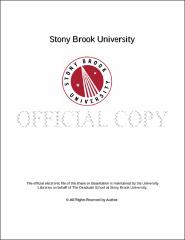| dc.identifier.uri | http://hdl.handle.net/11401/77154 | |
| dc.description.sponsorship | This work is sponsored by the Stony Brook University Graduate School in compliance with the requirements for completion of degree. | en_US |
| dc.format | Monograph | |
| dc.format.medium | Electronic Resource | en_US |
| dc.language.iso | en_US | |
| dc.publisher | The Graduate School, Stony Brook University: Stony Brook, NY. | |
| dc.type | Dissertation | |
| dcterms.abstract | Cellulose nascent crystals or cellulose microfibrils, extracted from biomass through TEMPO-mediated oxidation, are low cost, biocompatible and high performance materials that have found wide applications in various fields, including water purification, polymer nanocomposites, biosensors, and tissue engineering. However, several fundamental aspects of the structure characterization of these cellulose nascent crystals and microfibrils have still been ambiguous. The current study uses synchrotron small-angle X-ray scattering (SAXS) to characterize the structure of cellulose nanofibers (and their aggregates) and corresponding dispersed microfibrils from various sources (e.g. wood, bamboo, cotton, jute, etc.) in aqueous suspensions. It was revealed that typical cellulose nanofibers extracted from the dried wood pulp were of the ribbon shape with lengths in the 1 μ m range and cross-section sizes from 3 nm × 8 nm to 9 nm × 20 nm, depending on the source. In contrast, microfibril fractions extracted from never-dried dilignified Spruce wood were in the form of " nanostrips" with widths and thicknesses of around 4 nm and 0.5 nm, respectively. The thickness determination indicated that these nanostrips were comprised of only a monolayer of cellulose molecules. The molecular arrangement in these two-dimensional crystals was determined from wide-angle X-ray diffraction (WAXD). The structural results acquired from the X-ray scattering/diffraction techniques were consistent with other characterization results, including transmission electron microscopy (TEM), atomic force microscopy (AFM) and nuclear magnetic resonance (NMR). | |
| dcterms.abstract | Cellulose nascent crystals or cellulose microfibrils, extracted from biomass through TEMPO-mediated oxidation, are low cost, biocompatible and high performance materials that have found wide applications in various fields, including water purification, polymer nanocomposites, biosensors, and tissue engineering. However, several fundamental aspects of the structure characterization of these cellulose nascent crystals and microfibrils have still been ambiguous. The current study uses synchrotron small-angle X-ray scattering (SAXS) to characterize the structure of cellulose nanofibers (and their aggregates) and corresponding dispersed microfibrils from various sources (e.g. wood, bamboo, cotton, jute, etc.) in aqueous suspensions. It was revealed that typical cellulose nanofibers extracted from the dried wood pulp were of the ribbon shape with lengths in the 1 μ m range and cross-section sizes from 3 nm × 8 nm to 9 nm × 20 nm, depending on the source. In contrast, microfibril fractions extracted from never-dried dilignified Spruce wood were in the form of " nanostrips" with widths and thicknesses of around 4 nm and 0.5 nm, respectively. The thickness determination indicated that these nanostrips were comprised of only a monolayer of cellulose molecules. The molecular arrangement in these two-dimensional crystals was determined from wide-angle X-ray diffraction (WAXD). The structural results acquired from the X-ray scattering/diffraction techniques were consistent with other characterization results, including transmission electron microscopy (TEM), atomic force microscopy (AFM) and nuclear magnetic resonance (NMR). | |
| dcterms.available | 2017-09-20T16:52:06Z | |
| dcterms.contributor | Hsiao, Benjamin S | en_US |
| dcterms.contributor | Hanson, David | en_US |
| dcterms.contributor | Chu, Benjamin | en_US |
| dcterms.contributor | Lauher, Joseph | en_US |
| dcterms.contributor | Mahajan, Devinder. | en_US |
| dcterms.creator | Su, Ying | |
| dcterms.dateAccepted | 2017-09-20T16:52:06Z | |
| dcterms.dateSubmitted | 2017-09-20T16:52:06Z | |
| dcterms.description | Department of Chemistry. | en_US |
| dcterms.extent | 130 pg. | en_US |
| dcterms.format | Monograph | |
| dcterms.format | Application/PDF | en_US |
| dcterms.identifier | http://hdl.handle.net/11401/77154 | |
| dcterms.issued | 2015-08-01 | |
| dcterms.language | en_US | |
| dcterms.provenance | Made available in DSpace on 2017-09-20T16:52:06Z (GMT). No. of bitstreams: 1
Su_grad.sunysb_0771E_12187.pdf: 7135863 bytes, checksum: 85899d87d6b39461d9ae92517e4d35c1 (MD5)
Previous issue date: 2014 | en |
| dcterms.publisher | The Graduate School, Stony Brook University: Stony Brook, NY. | |
| dcterms.subject | cellulose microfibrils, cellulose nanofibers, structure characterization, TEMPO-mediated oxidation, X-ray scattering | |
| dcterms.subject | Chemistry | |
| dcterms.title | Structure Characterization of Cellulose Nanofibers/Microfibrils | |
| dcterms.type | Dissertation | |

